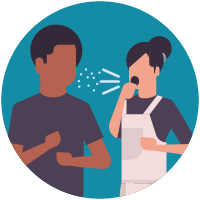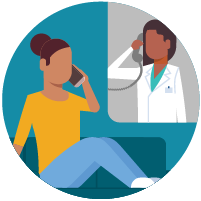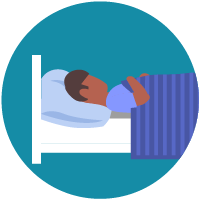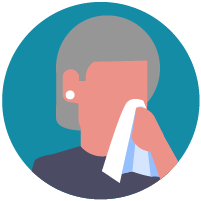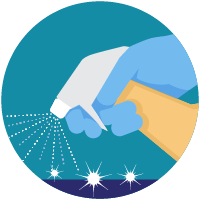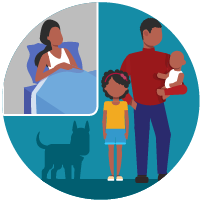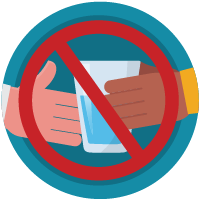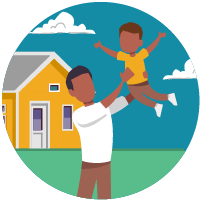Coronavirus
What is COVID-19
COVID-19 (Novel Coronavirus-19) is a new strain of coronavirus (a large family of viruses) that had previously not been identified in humans. It first emerged in Wuhan, China, in December 2019, and has since been declared as an outbreak by the World Health Organization (WHO). In very rare cases, the disease could be fatal. Older people or patients who already have diseases such as diabetes or heart problems may be vulnerable to becoming severely ill because of this virus. There is no coronavirus vaccine yet.
Symptoms of COVID-19
These symptoms may appear 2-14 days after exposure (based on the incubation period of MERS-CoV viruses).
How to protect yourself
1) Know How it Spreads
- There is currently no vaccine to prevent coronavirus disease 2019 (COVID-19).
- The best way to prevent illness is to avoid being exposed to this virus.
- The virus is thought to spread mainly from person-to-person.
- Between people who are in close contact with one another (within about 6 feet).
- Through respiratory droplets produced when an infected person coughs or sneezes.
- These droplets can land in the mouths or noses of people who are nearby or possibly be inhaled into the lungs.
2) Take steps to protect yourself
Clean your hands often
- Wash your hands often with soap and water for at least 20 seconds especially after you have been in a public place, or after blowing your nose, coughing, or sneezing.
- If soap and water are not readily available, use a hand sanitizer that contains at least 60% alcohol. Cover all surfaces of your hands and rub them together until they feel dry.
- Avoid touching your eyes, nose, and mouth with unwashed hands.
Avoid close contact
- Avoid close contact with people who are sick
- Put distance between yourself and other people if COVID-19 is spreading in your community. This is especially important for people who are at higher risk of getting very sick.
3) Take steps to protect others
- Stay home if you are sick, except to get medical care. Learn what to do if you are sick.
- Cover your mouth and nose with a tissue when you cough or sneeze or use the inside of your elbow.
- Throw used tissues in the trash.
- Immediately wash your hands with soap and water for at least 20 seconds. If soap and water are not readily available, clean your hands with a hand sanitizer that contains at least 60% alcohol.
- If you are sick: You should wear a facemask when you are around other people (e.g., sharing a room or vehicle) and before you enter a healthcare provider’s office. If you are not able to wear a facemask (for example, because it causes trouble breathing), then you should do your best to cover your coughs and sneezes, and people who are caring for you should wear a facemask if they enter your room. Learn what to do if you are sick.
- If you are NOT sick: You do not need to wear a facemask unless you are caring for someone who is sick (and they are not able to wear a facemask). Facemasks may be in short supply and they should be saved for caregivers.
- Clean AND disinfect frequently touched surfaces daily. This includes tables, doorknobs, light switches, countertops, handles, desks, phones, keyboards, toilets, faucets, and sinks.
- If surfaces are dirty, clean them: Use detergent or soap and water prior to disinfection.
What To Do if You Are Sick
Steps to help prevent the spread of COVID-19 if you are sick
Stay home except to get medical care
- Stay home: Most people with COVID-19 have mild illness and are able to recover at home without medical care. Do not leave your home, except to get medical care. Do not visit public areas.
- Stay in touch with your doctor. Call before you get medical care. Be sure to get care if you have trouble breathing, or have any other emergency warning signs, or if you think it is an emergency.
- Avoid public transportation: Avoid using public transportation, ride-sharing, or taxis.
Call ahead before visiting your doctor
- Call ahead: Many medical visits for routine care are being postponed or done by phone or telemedicine.
- If you have a medical appointment that cannot be postponed, call your doctor’s office, and tell them you have or may have COVID-19. This will help the office protect themselves and other patients.
If you are sick, wear a facemask in the following situations, if available.
- If you are sick: You should wear a facemask, if available, when you are around other people (including before you enter a healthcare provider’s office).
- If you are caring for others: If the person who is sick is not able to wear a facemask (for example, because it causes trouble breathing), then as their caregiver, you should wear a facemask when in the same room with them. Visitors, other than caregivers, are not recommended.
Note:During a public health emergency, facemasks may be reserved for healthcare workers. You may need to improvise a facemask using a scarf or bandana.
Cover your coughs and sneezes
- Cover: Cover your mouth and nose with a tissue when you cough or sneeze.
- Dispose: Throw used tissues in a lined trash can.
- Wash hands: Immediately wash your hands with soap and water for at least 20 seconds. If soap and water are not available, clean your hands with an alcohol-based hand sanitizer that contains at least 60% alcohol.
Clean your hands often
- Wash hands: Wash your hands often with soap and water for at least 20 seconds. This is especially important after blowing your nose, coughing, or sneezing; going to the bathroom; and before eating or preparing food.
- Hand sanitizer: If soap and water are not available, use an alcohol-based hand sanitizer with at least 60% alcohol, covering all surfaces of your hands and rubbing them together until they feel dry.
- Soap and water: Soap and water are the best option, especially if hands are visibly dirty.
- Avoid touching: Avoid touching your eyes, nose, and mouth with unwashed hands
Clean all “high-touch” surfaces everyday
Clean high-touch surfaces in your isolation area (“sick room” and bathroom) every day; let a caregiver clean and disinfect high-touch surfaces in other areas of the home.
- Clean and disinfect: Routinely clean high-touch surfaces in your “sick room” and bathroom. Let someone else clean and disinfect surfaces in common areas, but not your bedroom and bathroom.
- If a caregiver or other person needs to clean and disinfect a sick person’s bedroom or bathroom, they should do so on an as-needed basis. The caregiver/other person should wear a mask and wait as long as possible after the sick person has used the bathroom.
High-touch surfaces include phones, remote controls, counters, tabletops, doorknobs, bathroom fixtures, toilets, keyboards, tablets, and bedside tables.
- Clean and disinfect areas that may have blood, stool, or body fluids on them.
- Household cleaners and disinfectants: Clean the area or item with soap and water or another detergent if it is dirty. Then, use a household disinfectant.
- Be sure to follow the instructions on the label to ensure safe and effective use of the product. Many products recommend keeping the surface wet for several minutes to ensure germs are killed. Many also recommend precautions such as wearing gloves and making sure you have good ventilation during use of the product.
- Most EPA-registered household disinfectants should be effective.
Monitor your symptoms
- Common symptoms of COVID-19 include fever and cough. Trouble breathing is a more serious symptom that means you should get medical attention.
-
If you are having trouble breathing, seek medical attention, but call first.
- Call your doctor or emergency room before going in and tell them your symptoms. They will tell you what to do.
- Wear a facemask: If available, put on a facemask before you enter the building. If you can’t put on a facemask, cover your coughs and sneezes. Try to stay at least 6 feet away from other people. This will help protect the people in the office or waiting room.
- Follow care instructions from your healthcare provider and local health department: Your local health authorities may give instructions on checking your symptoms and reporting information.
How to discontinue home isolation
-
People with COVID-19 who have stayed home (home isolated) can stop home isolation under the following conditions:
- If you will not have a test to determine if you are still contagious, you can leave home after these three things have happened:
- You have had no fever for at least 72 hours (that is three full days of no fever without the use medicine that reduces fevers)
- other symptoms have improved (for example, when your cough or shortness of breath have improved)
- at least 7 days have passed since your symptoms first appeared
-
If you will be tested to determine if you are still contagious, you can leave home after these three things have happened:
- You no longer have a fever (without the use medicine that reduces fevers)
- other symptoms have improved (for example, when your cough or shortness of breath have improved)
- you received two negative tests in a row, 24 hours apart.
- If you will not have a test to determine if you are still contagious, you can leave home after these three things have happened:
In all cases, follow the guidance of your healthcare provider and local health department. The decision to stop home isolation should be made in consultation with your healthcare provider and state and local health departments. Local decisions depend on local circumstances.
Caring for someone at home
Most people who get sick with COVID-19 will have only mild illness and should recover at home.* Care at home can help stop the spread of COVID-19 and help protect people who are at risk for getting seriously ill from COVID-19.
If you are caring for someone at home, monitor for emergency signs, prevent the spread of germs, treat symptoms, and carefully consider when to end home isolation.
*Note: Older adults and people of any age with certain serious underlying medical conditions like lung disease, heart disease, or diabetes are at higher risk for developing more serious complications from COVID-19 illness and should seek care as soon as symptoms start.
Monitor the person for worsening symptoms. Know the emergency warning signs.
- Have their healthcare provider’s contact information on hand.
- If they are getting sicker, call their healthcare provider. For medical emergencies, call emergency number and notify the dispatch personnel that they have or are suspected to have COVID-19.
- Have the person stay in one room, away from other people, including yourself, as much as possible.
- If possible, have them use a separate bathroom.
- Avoid sharing personal household items, like dishes, towels, and bedding
- If facemasks are available, have them wear a facemask when they are around people, including you.
- It the sick person can’t wear a facemask, you should wear one while in the same room with them, if facemasks are available.
- If the sick person needs to be around others (within the home, in a vehicle, or doctor’s office), they should wear a facemask.
- Wash your hands often with soap and water for at least 20 seconds, especially after interacting with the sick person. If soap and water are not readily available, use a hand sanitizer that contains at least 60% alcohol. Cover all surfaces of your hands and rub them together until they feel dry.
- Avoid touching your eyes, nose, and mouth.
- Every day, clean all surfaces that are touched often, like counters, tabletops, and doorknobs
- Use household cleaning sprays or wipes according to the label instructions.
- Wash laundry thoroughly.
- If laundry is soiled, wear disposable gloves and keep the soiled items away from your body while laundering. Wash your hands immediately after removing gloves.
- Avoid having any unnecessary visitors.
- For any additional questions about their care, contact their healthcare provider or state or local health department.
Provide symptom treatment
- Make sure the sick person drinks a lot of fluids to stay hydrated and rests at home.
- Over-the-counter medicines may help with symptoms.
- For most people, symptoms last a few days and get better after a week.
When to end home isolation (staying home)
- People with COVID-19 who have stayed home (are home isolated) can stop home isolation under the following conditions:
- If they will not have a test to determine if they are still contagious, they can leave home after these three things have happened:
- They have had no fever for at least 72 hours (that is three full days of no fever without the use medicine that reduces fevers)
AND - other symptoms have improved (for example, when their cough or shortness of breath have improved)
AND - at least 7 days have passed since their symptoms first appeared
- They have had no fever for at least 72 hours (that is three full days of no fever without the use medicine that reduces fevers)
- If they will be tested to determine if they are still contagious, they can leave home after these three things have happened:
- They no longer have a fever (without the use medicine that reduces fevers)
AND - other symptoms have improved (for example, when their cough or shortness of breath have improved)
AND - They received two negative tests in a row, 24 hours apart.
- They no longer have a fever (without the use medicine that reduces fevers)
- If they will not have a test to determine if they are still contagious, they can leave home after these three things have happened:
- Over-the-counter medicines may help with symptoms.
- For most people, symptoms last a few days and get better after a week.


